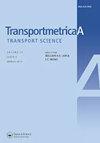将具有严格容量约束的静态交通分配模型扩展为半动态交通分配模型
IF 3.1
2区 工程技术
Q2 TRANSPORTATION
引用次数: 0
摘要
为了提高拥挤条件下大规模战略交通模型的准确性,本文将静态容量约束交通分配模型直接扩展为半动态模型。半动态模型比静态模型更精确,因为它放松了空网络假设,但与动态模型不同的是,它保持了在大规模战略运输模型系统中应用所需的稳定性和可扩展性。应用表明,与静态模型相反,半动态队列大小和延迟与动态结果非常相似,而由于遗漏溢出,只有拥塞模式不同。静态和半动态模型能够达到用户平衡条件,而动态模型则不能。在现实世界的运输模型中,静态模型忽略了高达76%的集体损失。因此,空网络假设很可能影响基于静态模型结果的(政策)决策。本文章由计算机程序翻译,如有差异,请以英文原文为准。
Extension of a static into a semi-dynamic traffic assignment model with strict capacity constraints
To improve the accuracy of large-scale strategic transport models in congested conditions, this paper presents a straightforward extension of a static capacity-constrained traffic assignment model into a semi-dynamic version. The semi-dynamic model is more accurate than its static counterpart as it relaxes the empty network assumption, but, unlike its dynamic counterpart, maintains the stability and scalability properties required for application in large-scale strategic transport model systems. Applications show that, contrary to static models, semi-dynamic queue sizes and delays are very similar to dynamic outcomes, whereas only the congestion patterns differ due to the omission of spillback. The static and semi-dynamic models are able to reach user equilibrium conditions, whereas the dynamic model cannot. On a real-world transport model, the static model omits up to 76% of collective losses. It is therefore very likely that the empty network assumption influences (policy) decisions based on static model outcomes.
求助全文
通过发布文献求助,成功后即可免费获取论文全文。
去求助
来源期刊

Transportmetrica A-Transport Science
TRANSPORTATION SCIENCE & TECHNOLOGY-
CiteScore
8.10
自引率
12.10%
发文量
55
期刊介绍:
Transportmetrica A provides a forum for original discourse in transport science. The international journal''s focus is on the scientific approach to transport research methodology and empirical analysis of moving people and goods. Papers related to all aspects of transportation are welcome. A rigorous peer review that involves editor screening and anonymous refereeing for submitted articles facilitates quality output.
 求助内容:
求助内容: 应助结果提醒方式:
应助结果提醒方式:


